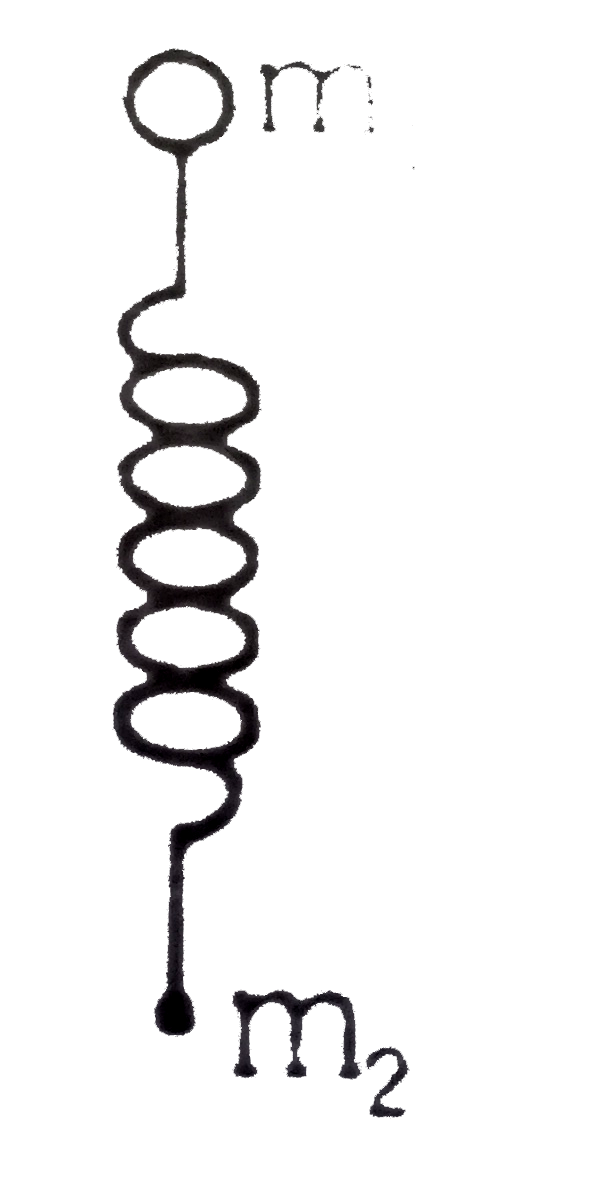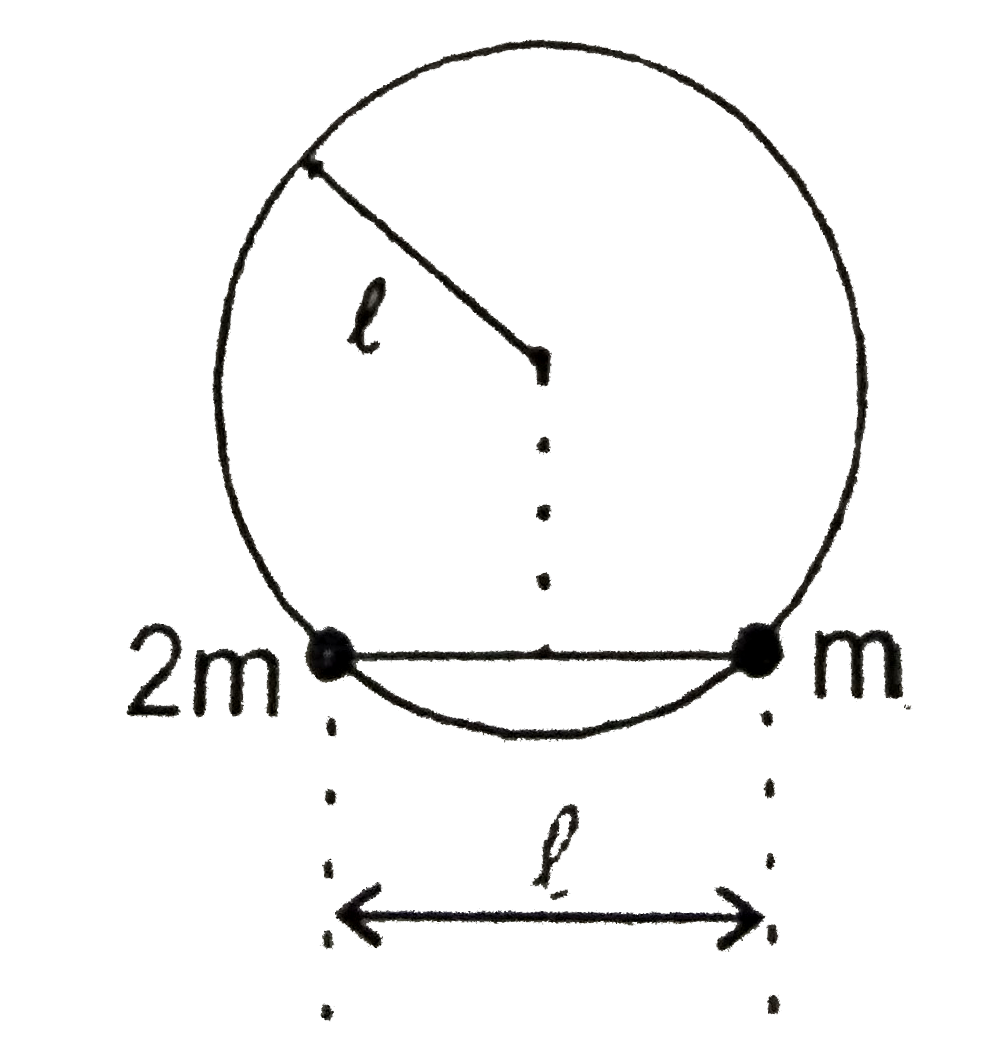Two point masses m1 and m2 are connected by a spring of natural length l0. The spring is compressed such that the two point masses touch each other and then they are fastened by a string. Then the system is moved with a velocity v0 along positive x-axis. When the system reached the origin, the string breaks (t=0). The position of the point mass m1 is given by x1=v0t−A(1−cosωt) where A and ω are constants. Find the position of the second block as a function of time. Also, find the relation between A and l0.
The correct Answer is:A, B, C
To solve the problem step by step, we will start with the information provided and derive the position of the second mass as a function of time, as well as the relationship between A and l0.
Step 1: Understanding the System
We have two point masses m1 and m2 connected by a spring of natural length l0. Initially, the spring is compressed, and the two masses touch each other. The system moves with a velocity v0 until the string holding them together breaks at t=0.
Step 2: Position of Mass m1
The position of mass m1 is given by:
x1=v0t−A(1−cos(ωt))
Step 3: Finding the Velocity of Mass m1
To find the velocity of mass m1, we differentiate the position with respect to time:
v1=dx1dt=v0−Aωsin(ωt)
Step 4: Conservation of Momentum
Since no external forces are acting on the system in the x-direction, the momentum must be conserved. Initially, the total momentum is:
Pinitial=(m1+m2)v0
After the string breaks, the momentum is:
Pfinal=m1v1+m2v2
Setting these equal gives us:
(m1+m2)v0=m1(v0−Aωsin(ωt))+m2v2
Step 5: Solving for v2
Rearranging the equation for v2:
m2v2=(m1+m2)v0−m1(v0−Aωsin(ωt))
v2=v0+m1m2Aωsin(ωt)
Step 6: Finding the Position of Mass m2
To find the position x2 of mass m2, we integrate v2:
x2=∫v2dt=∫(v0+m1m2Aωsin(ωt))dt
x2=v0t−m1m2Acos(ωt)+C
Assuming the constant of integration C=0 at t=0:
x2=v0t−m1m2A(1−cos(ωt))
Step 7: Relation Between A and l0
For the spring to return to its natural length l0, the distance between the two masses must equal l0:
x2−x1=l0
Substituting the expressions for x1 and x2:
(v0t−m1m2A(1−cos(ωt)))−(v0t−A(1−cos(ωt)))=l0
Simplifying gives:
(−m1m2A(1−cos(ωt))+A(1−cos(ωt)))=l0
Factoring out (1−cos(ωt)):
A(1−cos(ωt))(1−m1m2)=l0
Thus, we find the relationship between A and l0:
A(1−m1m2)=l0
Final Answers
1. The position of mass m2 as a function of time is:
x2=v0t−m1m2A(1−cos(ωt))
2. The relation between A and l0 is:
A(1−m1m2)=l0
We have two point masses m1 and m2 connected by a spring of natural length l0. Initially, the spring is compressed, and the two masses touch each other. The system moves with a velocity v0 until the string holding them together breaks at t=0.
The position of mass m1 is given by:
x1=v0t−A(1−cos(ωt))
To find the velocity of mass m1, we differentiate the position with respect to time:
v1=dx1dt=v0−Aωsin(ωt)
Since no external forces are acting on the system in the x-direction, the momentum must be conserved. Initially, the total momentum is:
Pinitial=(m1+m2)v0
After the string breaks, the momentum is:
Pfinal=m1v1+m2v2
Setting these equal gives us:
(m1+m2)v0=m1(v0−Aωsin(ωt))+m2v2
Rearranging the equation for v2:
m2v2=(m1+m2)v0−m1(v0−Aωsin(ωt))
v2=v0+m1m2Aωsin(ωt)
To find the position x2 of mass m2, we integrate v2:
x2=∫v2dt=∫(v0+m1m2Aωsin(ωt))dt
x2=v0t−m1m2Acos(ωt)+C
Assuming the constant of integration C=0 at t=0:
x2=v0t−m1m2A(1−cos(ωt))
For the spring to return to its natural length l0, the distance between the two masses must equal l0:
x2−x1=l0
Substituting the expressions for x1 and x2:
(v0t−m1m2A(1−cos(ωt)))−(v0t−A(1−cos(ωt)))=l0
Simplifying gives:
(−m1m2A(1−cos(ωt))+A(1−cos(ωt)))=l0
Factoring out (1−cos(ωt)):
A(1−cos(ωt))(1−m1m2)=l0
Thus, we find the relationship between A and l0:
A(1−m1m2)=l0
1. The position of mass m2 as a function of time is:
x2=v0t−m1m2A(1−cos(ωt))
2. The relation between A and l0 is:
A(1−m1m2)=l0
Topper's Solved these Questions
- BOOK - DC PANDEY ENGLISHCHAPTER - CENTRE OF MASS, LINEAR MOMENTUM AND COLLISIONEXERCISE - Level 2 Comprehension Based Questions3videos
CENTRE OF MASS, LINEAR MOMENTUM AND COLLISION
- BOOK - DC PANDEY ENGLISHCHAPTER - CENTRE OF MASS, IMPULSE AND MOMENTUMEXERCISE - Comprehension type questions15videos
CENTRE OF MASS, IMPULSE AND MOMENTUM
- BOOK - DC PANDEY ENGLISHCHAPTER - CIRCULAR MOTIONEXERCISE - Medical entrances s gallery19videos
CIRCULAR MOTION
Similar Questions
The two masses m1 and m2 are joined by a spring as shown. The system is dropped to the ground from a height. The spring will be
 View Solution
View SolutionTwo particles of masses m1andm2 are connected to a string and the system is rotated in a horizontal plane with 'P' as center. The ratio of tension in the two parts of string is
 View Solution
View SolutionTwo masses m1andm2 re connected by a spring of spring constant k and are placed on as frictionless horizontal surface. Initially the spring is stretched through a distance x0 when the system is released from rest. Find the distance moved by the two masses before they again come to rest.
View SolutionA particle of mass m is moving with constant velocity v0 along the line y=b. At time t=0 it was at the point (0,b). At time t=bv0, the
 View Solution
View SolutionA stone of mass m tied to a string of length l is rotated in a circle with the other end of the string as the centre. The speed of the stone is v. If the string breaks, the stone will move
View SolutionTwo masses m1andm2 are connected to the end of a string passing over a smooth pulley . The magnitude of tension in the string is T and the masses are moving with magnitude of acceleration a . If the masses are interchanged , then
View SolutionTwo blocks of masses m1andm2 are connected by a spring of spring constant k figure. The block of mass m2 is given a shape impulse so that it acquires a velocity v0 towards right. Find a. the velocity of the centre of mass b. the maximum elongation that the spring will suffer.
 View Solution
View SolutionTwo beads of mass 2m and m, connected by a rod of length l and of negligible mass are free to move in a smooth vertical circular wire frame of radius l as shown. Initially the system is held in horizontal position ( Refer figure )

If the rod is replaced by a massless string of length l and the system is released when the string is horizontal then :View SolutionTwo blocks of masses m1=1kg and m2 = 2kg are connected by a spring of spring constant k = 24 N/m and placed on a frictionless horizontal surface. The block m1 is imparted an initial velocity v0 = 12cm/s to the right. The amplitude of oscillation is
View SolutionTwo blocks of masses m1 and m2 are connected to each other with the help of a spring. If pushing force F is given to the mass m1 providing acceleration a to it, then acceleration of m2 is
 View Solution
View Solution

